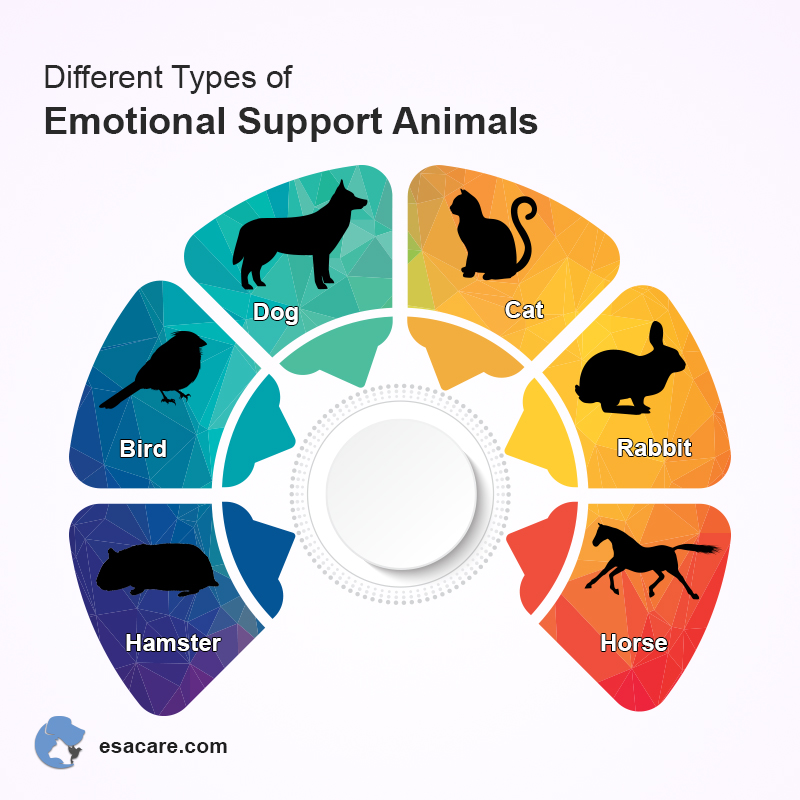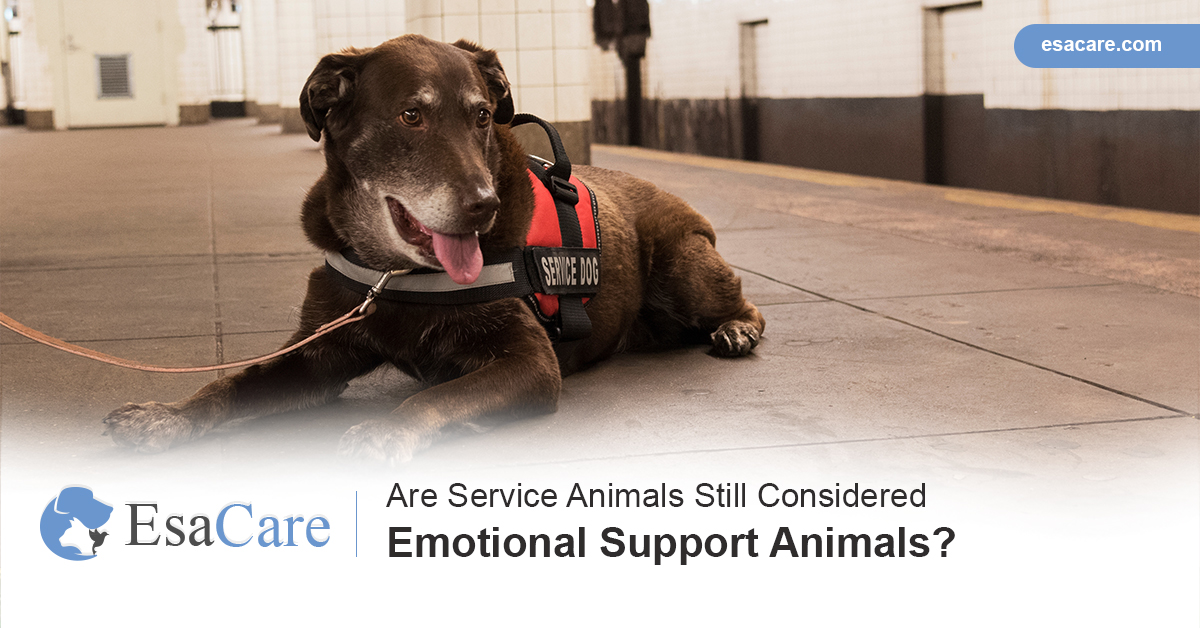Are Service Animals Considered Emotional Support Animals?
Studies show that about 26% of the American population lives with disabilities. Service dogs are currently helping about 80 million of these Americans lead everyday lives without relying on others. With proper training and patience, any dog can become a service dog.
ESAs can help you to deal with PTSD. Click the button below to get your ESA letter.
However, retrievers are usually the go-to option because they are gentle, are very trainable, and are intelligent. Many people typically confuse service animals with emotional support animals and with good reason. So are service animals still considered emotional support animals?
What Is the Difference Between a Service Animal Vs. an Emotional Support Animal?
According to the Americans with Disabilities Act, a service animal is any dog trained to perform tasks for the benefit of an individual living with a disability, including people with physical, sensory, psychiatric, intellectual, and mental disabilities.
The ADA defines emotional support animals as any animal that provides emotional support and alleviates one or numerous symptoms of a person’s disability. ESAs provide companionship and relieve their owners of loneliness.
Sometimes ESAs help with anxiety, depression, and other phobias. They, however, aren’t trained to perform specific tasks to assist individuals with disabilities. Occasionally emotional support animals get categorized in the same bracket as therapy animals. They are, however, not protected under the ADA like service animals.
The Fair Housing Act protects emotional support animals by mandating that no one should be discriminated against because of their disability when obtaining a home. As a result, policies such as no pets or pet size limitations don’t apply to people with an ESA prescription.
The property owner isn’t also allowed to charge the tenant any pet deposit for having an emotional support animal living with them. Emotional Support Animals are also protected under the air carrier access act, which stipulates that airlines should allow for ESAs and service animals to accompany their handlers in the cabin.
Many people can’t tell what animals can be service animals. So which animals are recognized as service animals? The most common types of service animals are dogs, with rare cases being miniature ponies. Emotional support animals, on the other hand, vary from birds, reptiles to canines.
The significant difference between the two is that ESAs typically alleviate effects by being a present figure and providing affection to the affected individual. Service dogs do more than provide cuddles to their handlers as they are trained to perform specific tasks to aid an individual with a disability.

Different Types of ESAs
Where Are Emotional Support Animals Not Allowed?
To apply for an ESA, you have to be evaluated by a certified mental health professional such as ESA Care, who will recommend the best emotional support animals to help you go on with your daily life. You can get your existing pet as an ESA, or you can purchase or adopt other animals specifically to bring you comfort, affection, and emotional stability.
Unlike service dogs, who can go almost everywhere, emotional support animals don’t get the same privileges and rights regarding public access. Below are some of the places where your ESA won’t be allowed entry.
1. Airbnb’s and Hotels
Hotels are usually considered as temporary housings. Therefore the general rule is that no pets are allowed, and the law applies to your ESA as well. Most establishments will view your ESA as a pet and will therefore not grant your pet access.
However, Airbnb’s are slightly flexible with the rule, but you still need to ensure that you ask the owner earlier before showing up with your ESA. If you demonstrate that your pet is well-behaved and trained, some hotels and Airbnb’s might allow you to stay. Always contact the place before the arrival date to confirm if it’s okay. Also, let them know that your pet is well-behaved.
2. Restaurants and Stores
Most people think that restaurants and other businesses are obligated to allow an emotional support animal. This is not true as, unlike service dogs who have access to such establishments, a business is at will to deny your ESA entry. If you like to go with your ESA to the store, always call ahead or let the store manager know that your ESA is well-behaved.
ESA dog can be your best companion. Click the button below to get your ESA letter.
3. Workplaces
Some workplaces are okay with employees bringing their emotional support animals to work with them. However, most employers tend to frown at this, especially if the pet isn’t well trained. This is because some pets are destructive and can end up distracting other workers.
If you want to bring your ESA to work, you can appeal to your office manager to allow your ESA to enter the workplace. However, the pet is entirely your responsibility if the request is accepted.
How to Catch a Fake Service Dog?
As we’ve mentioned, a service dog typically helps disabled individuals with some tasks to ease their everyday life. However, some people try to pass their dogs as service dogs to enjoy the privileges that actual service dogs enjoy. That said, here are three sure signs that a service dog is an impostor.
1. The Owner Is Pushing the Dog in a Cart or Carrying Them
This is a tough one to use because some smaller dog breeds are usually trained to monitor their owner’s heartbeat. Therefore the owner always has to hold it closer to their heart. Regardless, service dogs receive holistic training on how to better the life of a disabled person meaning that they are always alert and ready to help.
If you spot a “service dog” being pushed around the store on a cart or carried in a purse, chances are that the dog is a fake.

Different Types of Service Dogs
2. The Owner Doesn’t Have Them on the Leash
Again, this is a challenging aspect to go on since some well-trained and experienced service dogs can help their owner without needing a leash. However, you’ll often find that most service dogs have leashes to protect them. Therefore, if the service dog in question is not on a leash, there is a high likelihood that the owner is posing.
Another red flag is if the dog is pulling on the leash. Many service dogs are used to always being on a leash and therefore have excellent leash manners. They never tag on it and always do their best to stick by their human’s side. Any dog yanking the leash in opposite directions unnecessarily might be a fake service dog.
3. Aggression
Service dogs are trained to protect their owner if the need ever arises. That doesn’t mean, though, that they will unnecessarily growl or bark at a passerby without explicit instructions to do so. Any dog that growls, lunges, or displays other unwarranted aggression signs is a fake service dog.
Fake service dogs downplay the need for real service dogs for people who actually need the animals for any medical purposes. They are also offensive to all the dogs that go through rigorous training to be as good at their jobs as they are. If you’re curious about a person and their dog, it is best to approach them politely. Keep in mind that they don’t have to answer any of your questions.
ESAs can improve your overall mental health. Click the button below to get your ESA letter.
To Sum It up
If you require an ESA, be sure to talk to your mental health professional for their opinion and certification. Ensure to check with your specific state about the types of rights you have regarding your ESA, as the laws might be different in other states.
Contact Us at ESACare to get an ESA letter or click the banner below to book your appointment.










 347 5th Ave Suite 1402-112,
347 5th Ave Suite 1402-112,

Leave a Reply
Want to join the discussion?Feel free to contribute!